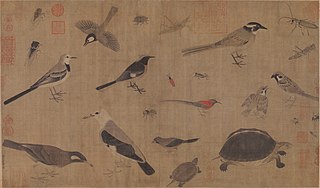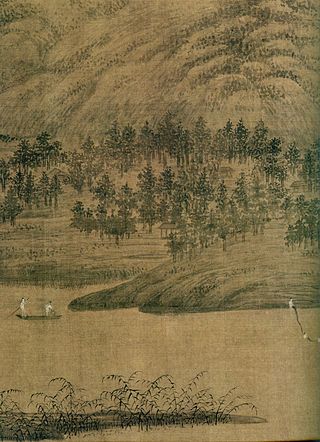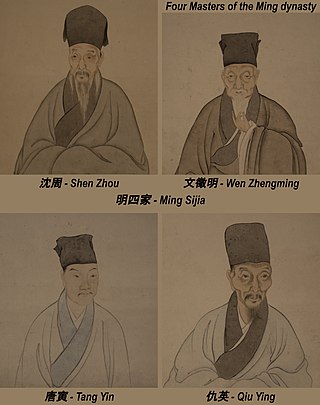- ↑ "Zhang Zeduan: Painting | China Online Museum - Chinese Art Galleries". www.chinaonlinemuseum.com.
Related Research Articles

Ink wash painting ; is a type of Chinese ink brush painting which uses washes of black ink, such as that used in East Asian calligraphy, in different concentrations. It emerged during the Tang dynasty of China (618–907), and overturned earlier, more realistic techniques. It is typically monochrome, using only shades of black, with a great emphasis on virtuoso brushwork and conveying the perceived "spirit" or "essence" of a subject over direct imitation. Ink wash painting flourished from the Song dynasty in China (960–1279) onwards, as well as in Japan after it was introduced by Zen Buddhist monks in the 14th century. Some Western scholars divide Chinese painting into three periods: times of representation, times of expression, and historical Oriental art. Chinese scholars have their own views which may be different; they believe that contemporary Chinese ink wash paintings are the pluralistic continuation of multiple historical traditions.

Chinese painting is one of the oldest continuous artistic traditions in the world. Painting in the traditional style is known today in Chinese as guó huà, meaning "national painting" or "native painting", as opposed to Western styles of art which became popular in China in the 20th century. It is also called danqing. Traditional painting involves essentially the same techniques as calligraphy and is done with a brush dipped in black ink or coloured pigments; oils are not used. As with calligraphy, the most popular materials on which paintings are made are paper and silk. The finished work can be mounted on scrolls, such as hanging scrolls or handscrolls. Traditional painting can also be done on album sheets, walls, lacquerware, folding screens, and other media.

Fan Zhongzheng, courtesy name Zhongli, better known by his pseudonym Fan Kuan, was a Chinese landscape painter of the Song dynasty. He was both a Daoist and a Neo-Confucianist.

Dong Yuan was a Chinese painter.

Chang Dai-chien or Zhang Daqian was one of the best-known and most prodigious Chinese artists of the twentieth century. Originally known as a guohua (traditionalist) painter, by the 1960s he was also renowned as a modern impressionist and expressionist painter. In addition, he is regarded as one of the most gifted master forgers of the twentieth century.
The Four Wangs were four Chinese landscape painters during the Qing dynasty in the 17th century, all with the surname Wang. They are best known for their accomplishments in shan shui painting.

Shitao or Shi Tao, born into the Ming dynasty imperial clan as Zhu Ruoji (朱若極), was a Chinese Buddhist monk, calligrapher, and landscape painter during the early Qing dynasty.

Qian Xuan, courtesy name Shun Ju (舜举), pseudonyms Yu Tan, Xi Lanweng (习嬾翁), and Zha Chuanweng (霅川翁), was a Chinese painter from Huzhou (湖州), the present day Wuxing District in Zhejiang. He lived during the late Song dynasty and early Yuan dynasty.

Along the River During the Qingming Festival is a handscroll painting by the Song dynasty painter Zhang Zeduan (1085–1145) and copied or recreated many times in the following centuries. It captures the daily life of people and the landscape of the capital, Bianjing during the Northern Song. The theme is often said to be the spirit and worldly commotion at the Qingming Festival, rather than the holiday's ceremonial aspects, such as tomb sweeping and prayers. Read right to left, as a viewer would unroll it, successive scenes reveal the lifestyle of all levels of the society from rich to poor as well as economic activities in both rural areas and the city, and offer glimpses of clothing and architecture. The painting is considered the most renowned work among all Chinese paintings, and it has been called "China's Mona Lisa."

Shan shui refers to a style of traditional Chinese painting that involves or depicts scenery or natural landscapes, using a brush and ink rather than more conventional paints. Mountains, rivers and waterfalls are common subjects of shan shui paintings.

Chen Hongshou, formerly romanized as Ch'en Hung-shou, was a Chinese painter of the late Ming dynasty.

During the Ming dynasty (1368–1644), Chinese painting progressed further basing on the achievements in painted art during the earlier Song dynasty and Yuan dynasty. The painting techniques which were invented and developed before the Ming period became classical during this period. More colours were used in painting during the Ming dynasty. Seal brown became much more widely used, and even over-used during this period. Many new painting skills or techniques were innovated and developed, calligraphy was much more closely and perfectly combined with the art of painting. Chinese painting reached another climax in the mid and late Ming. The painting was derived in a broad scale, many new schools were born, and many outstanding masters emerged.

The Song dynasty was a culturally rich and sophisticated age for China. It saw great advancements in the visual arts, music, literature, and philosophy. Officials of the ruling bureaucracy, who underwent a strict and extensive examination process, reached new heights of education in Chinese society, while general Chinese culture was enhanced by widespread printing, growing literacy, and various arts.

During the Tang dynasty, as a golden age in Chinese civilization, Chinese painting developed dramatically, both in subject matter and technique.The advancements in depth, technique, style, intricacy, complexity, and sophistication that characterized the paintings of the Tang era. This dramatic development was a consequence of the era’s embrace of openness and exploration into novel materials and techniques, contributing to new styles in landscape painting. Literature on art, in addition to the increase in the range of colors, added to the development of painting, widening the artistic imagination. However, this flourishing would not be possible without the interest and investment of the Tang court as it played a key role in bringing together painters from across the empire. The court lent tremendous support to the painters, thanks to which, they could devote their time and energy to mastering skills, experimenting with forms and styles, and mastering the painting skills. The court painters became more imaginative and creative, giving a new direction to landscape painting. As a result, the Tang era had an everlasting influence influence on Central and East Asian art.

Early Spring is a hanging scroll painting by Guo Xi. Completed in 1072, it is one of the most famous works of Chinese art from the Song dynasty. The work demonstrates his innovative techniques for producing multiple perspectives which he called "the angle of totality." The painting is a type of scroll painting which is called a Shan shui. The term "shan shui" describes a type of Chinese art in which scenes or natural landscapes are painted using an ink and brush. In literal terms, the name means "mountain-water-picture." In this kind of art, mountains, rivers, and frequently waterfalls are prominent. Around the tenth and eleventh centuries,[1] during the Song Dynasty, shan shui art first gained widespread recognition in China. The poem in the upper right corner was added in 1759 by the Qianlong Emperor. It reads:

The Four Masters of the Ming dynasty are a traditional grouping in Chinese art history of four famous Chinese painters that lived during the Ming dynasty. The group consists of Shen Zhou (1427–1509), Wen Zhengming (1470–1559), Tang Yin (1470–1523), and Qiu Ying (c.1494–c.1552). They were contemporaries, with Shen being the teacher of Wen, while Tang and Qiu was taught by Zhou Chen (1460–1535). All five of the aforementioned painters were part of the Wu School. Their styles and subject matter were varied. Qiu was solely a painter, while the other three developed distinct styles of painting, calligraphy, and poetry.
The Bian River, also known in Chinese as the Bian Shui (汴水), was an ancient river partly located within the borders of Kaifeng City, Henan, China.
Tang dynasty poet Pi Rixiu wrote about the river in his Treasured Memories of the Bian River (汴河怀古). Zhang Zeduan features the river running through Kaifeng in his Along the River During the Qingming Festival.

Shanshuipoetry or Shanshui shi refers to the movement in poetry, influenced by the shan shui (landscape) painting style, which became known as Shanshui poetry, or "landscape poetry". Sometimes, the poems were designed to be viewed with a particular work of art, others were intended to be "textual art" that evoked an image inside a reader's mind. It is one of the more important Classical Chinese poetry genres. Developing in the third and fourth centuries in China, Shanshui poetry contributed to the process of forming a unique aesthetic outlook.
Dongjing Meng Hua Lu or The Eastern Capital: A Dream of Splendor, is a memoir written by Meng Yuanlao. In 1126, Meng was made a refugee from Kaifeng, the thriving capital of the Northern Song dynasty after Jin dynasty conquered northern China and forced the withdrawal of the Song court to the temporary capital, Hangzhou, in the south, then known as Lin'an. Meng's book is a detailed and nostalgic description of the old capital's urban life, seasonal products, and festivals, as well as foods, customs, and traditions. In later dynasties, the book was much imitated and taken as an authoritative picture of affluent Chinese culture.

Wang Jiujiang is a Sichuanese painter whose work is mostly based on the landscapes of Sichuan and Tibet, by reinterpreting the traditional shan shui style. He is classified as a member of national first-class artists.
References
- Needham, Joseph (1971). Science and Civilisation in China : Volume 4, Physics and Physical Technology, Part 3, Civil Engineering and Nautics. Cambridge: Cambridge University Press.
External links
![]() Media related to Zhang Zeduan at Wikimedia Commons
Media related to Zhang Zeduan at Wikimedia Commons
- Zhang Zeduan and his Painting Gallery at China Online Museum
- Landscapes Clear and Radiant: The Art of Wang Hui (1632–1717), an exhibition catalog from The Metropolitan Museum of Art (fully available online as PDF), which contains material on Zhang Zeduan (see index)
| Zhang Zeduan | |||||||||||||||||||||
|---|---|---|---|---|---|---|---|---|---|---|---|---|---|---|---|---|---|---|---|---|---|
| Traditional Chinese | 張擇端 | ||||||||||||||||||||
| Simplified Chinese | 张择端 | ||||||||||||||||||||
| |||||||||||||||||||||
| International | |
|---|---|
| National | |
| Academics | |
| People | |